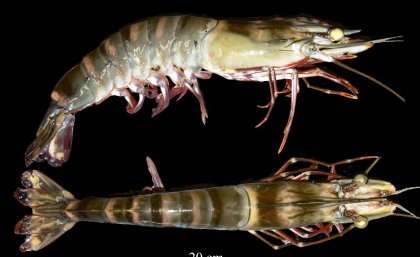Prawn spawn secrets unlocked in 3D images

Discovering the secrets of how one of the world's most popular prawn species produces sperm and transfers it to create the next generation could help free aquaculture from reliance on brood stock from the wild.
University of Queensland School of Agriculture and Food Sciences PhD student Tianyi Feng (Michael) is using advanced microscopy to create three-dimensional computer models of Australian giant black tiger prawn (Penaeus monodon) sperm.
Mr Feng said the giant black tiger prawn was a delicious high-quality species with distinctive stripes that turned red when cooked.
"Black tiger prawns were first described in the 18th century and are a premium-priced product, growing to about 20cm long, compared with 10-12cm for more commonly farmed species," he said.
"Although the seafood industry is a multi-billion dollar industry internationally, there's a lot we still don't understand about the basic biology of valuable prawns such as these.
"If we knew more we could probably improve the efficiency of prawn breeding in aquaculture."
Mr Feng said farmed prawns did not always mature well sexually in captivity, and the Asian prawn aquaculture industry had experienced significant setbacks from wild prawn diseases introduced by wild-caught brood stock.
"The aquaculture industry has been going in Australia for five decades, but there is still a reliance on wild-caught prawn brood stock," he said.
"Due to quarantine vigilance, Australia is fortunately free of serious prawn pathogens but our wild brood stock can be a vector for minor local diseases to enter farms.
"On the other hand, domesticated brood stock can be grown under bio-secure conditions- but it's important that they are also as fertile as possible.
"We're hoping to improve the knowledge of prawn sperm production using advanced techniques to assess sperm damage, such as DNA fragmentation, which is a cause of infertility in other species."
Mr Feng said crustacean sperm were very different to mammal sperm.
"Sperm have long swimming tails in mammals, but prawn sperm have no tails – they don't move at all and look more like thumb tacks, and it's an interesting mystery as to how the sperm gets into the egg," he said.
Mr Feng has used a new scanning electron microscopy technique to gain powerful detailed views of prawn sperm cells, richly illustrating their composition.
The research is published in the Journal of Morphology.
More information: Tianyi Feng et al. Three-dimensional reconstruction of black tiger prawn () spermatozoa using serial block-face scanning electron microscopy, Journal of Morphology (2016). DOI: 10.1002/jmor.20518
Journal information: Journal of Morphology
Provided by University of Queensland

















